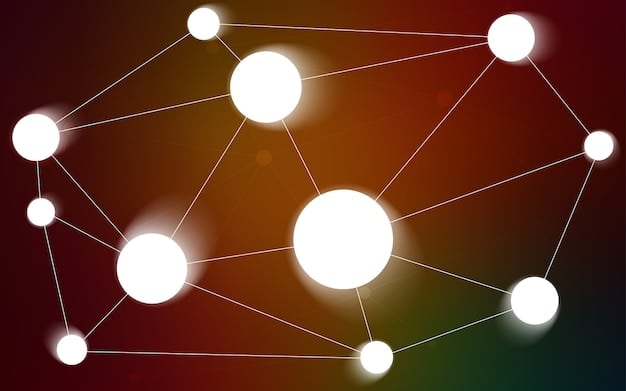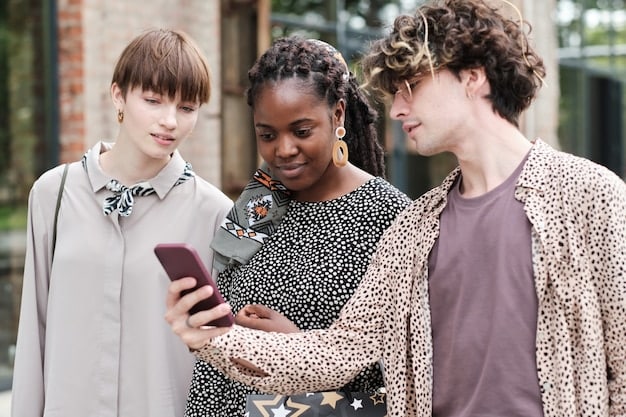How Social Media Algorithms Shape Pop Culture: Insider Insights

Social media algorithms profoundly impact pop culture by curating content, influencing trends, and shaping collective tastes, often amplifying specific narratives and creators while sidelining others, thereby redefining what becomes mainstream or niche.
In an age dominated by digital connectivity, understanding how social media algorithms shape pop culture: insider insights has become crucial. These intricate sets of rules quietly dictate what we see, hear, and consume, subtly molding trends, catapulting creators to stardom, and even influencing societal norms. Far from being neutral conduits, algorithms are active participants in the cultural conversation, and their influence is only growing.
The Algorithmic Genesis: From Clicks to Cultural Currents
The journey of a piece of content, from obscurity to global phenomenon, is increasingly governed by algorithms. These digital gatekeepers analyze vast amounts of data—our likes, shares, comments, watch times, and even pauses—to predict what will hold our attention next. This constant feedback loop doesn’t merely reflect popular culture; it actively sculpts it by prioritizing certain types of content and creators over others.
At their core, algorithms are designed for engagement. Every platform, be it TikTok, Instagram, X (formerly Twitter), or YouTube, employs sophisticated computational models to keep users scrolling, watching, and interacting. This drive for engagement inadvertently becomes a powerful engine of cultural dissemination, an almost invisible hand guiding the collective consciousness.
Understanding the Core Mechanics of Engagement
The mechanisms by which algorithms achieve this are multifaceted and constantly evolving. They aren’t static formulas but dynamic systems that learn and adapt based on user behavior. This adaptability is what makes them so potent and often, so unpredictable in their cultural impact.
- Relevance Ranking: Algorithms prioritize content they deem most relevant to an individual user based on past interactions and inferred interests.
- Proprietary Signals: Each platform utilizes unique signals, such as video completion rates on TikTok or hashtag usage on Instagram, to determine content visibility.
- Network Effects: Content shared and engaged with by a user’s direct network gains amplified visibility, creating viral loops.
- Timeliness: While some content benefits from longevity, breaking news and trending topics are often heavily favored by algorithms for real-time relevance.
The cumulative effect of these mechanics is a highly personalized feed for each user, yet paradoxically, this personalization often leads to collective trends forming and dissolving with unprecedented speed. A niche dance challenge on TikTok can become a global sensation overnight, or a forgotten song can resurface and top charts decades later, all thanks to algorithmic amplification.
Creators as Curators: Navigating the Algorithmic Labyrinth
For creators, understanding algorithm behavior is tantamount to survival and success. Artists, musicians, comedians, and influencers are no longer just producing content; they are becoming pseudo-data scientists, dissecting trends and adjusting their strategies to fit algorithmic preferences. This symbiotic relationship has fundamentally altered the creative process, injecting an element of strategic optimization.
The pressure to “feed the algorithm” can be immense, leading to content creation that prioritizes algorithmic visibility over purely artistic expression. This isn’t necessarily negative; it often fosters innovative approaches to storytelling and audience engagement. However, it also raises questions about authenticity and the long-term impact on creative integrity.
Strategic Approaches for Algorithmic Success
Successful creators often employ a blend of intuition and data-driven tactics. They analyze what resonates, both with their specific audience and with the broader algorithmic trends. This involves a continuous cycle of creation, analysis, and adaptation.
- Audience Segmentation: Tailoring content to specific audience demographics that algorithms can more easily identify and target.
- Platform-Specific Optimization: Understanding that what works on Instagram Reels might not work on YouTube Shorts, and adapting accordingly.
- Trendjacking (with authenticity): Riding the wave of existing trends, but adding a unique, personal spin to avoid being seen as purely derivative.
- Community Building: Fostering genuine engagement and interaction, as algorithms often reward strong community signals.
The rise of micro-influencers and niche communities also highlights the algorithmic paradox: while global trends emerge, algorithms also facilitate the discovery of highly specific content for smaller, dedicated audiences. This allows for a fragmentation of pop culture, where multiple “mainstreams” can coexist simultaneously.
The Viral Phenomenon: Engineered Serendipity and Its Ripple Effects
The concept of “going viral” is arguably the most visible manifestation of algorithmic power in pop culture. What once relied on word-of-mouth or traditional media now hinges on the rapid, exponential spread facilitated by algorithms. This engineered serendipity often feels magical, but it’s the result of countless data points aligning perfectly within a platform’s logic.
A viral moment, whether it’s a song, a dance, a meme, or a political commentary, can transcend its original context and become a cultural timestamp. It reflects the collective mood, sparks conversations, and often informs how we perceive current events and societal values. The accelerated pace of virality means trends emerge and fade with dizzying speed, making pop culture feel more ephemeral than ever.
Case Studies in Algorithmic Amplification
From “Old Town Road” dominating charts after a TikTok burst to the resurgence of classic songs via Instagram Reels, concrete examples abound. These instances showcase how algorithms can act as kingmakers, bypassing traditional industry gatekeepers and democratizing fame, at least in theory.
- TikTok and Music: The platform has become an unparalleled launchpad for new artists and a revival engine for old hits, often dictating which songs gain mainstream radio play.
- Memes as Cultural Commentary: Algorithms amplify memes, making them digestible and shareable forms of social and political commentary that disseminate rapidly across diverse user groups.
- Challenges and Trends: Dance challenges, niche fashion trends, and beauty hacks spread globally within days, driven by algorithmic pushes into user feeds.
The ripple effect extends beyond mere entertainment. Viral challenges have raised awareness for social causes, while viral misinformation has demonstrated the darker side of rapid algorithmic dissemination. The sheer power of these cascades necessitates a deeper critical understanding of their societal implications.

The Echo Chamber Effect: Homogenization vs. Fragmentation of Taste
One of the most debated aspects of algorithmic influence is the “echo chamber” or “filter bubble” effect. By consistently showing users content aligning with their existing preferences, algorithms can inadvertently reinforce biases and limit exposure to diverse viewpoints. In pop culture, this could mean highly individualized feeds might lead to a fragmentation of shared cultural experiences.
Conversely, algorithms also possess the power to homogenize. When a piece of content gains critical mass, its algorithmic boosting can push it into feeds across a wide spectrum of users, irrespective of their usual preferences. This can lead to certain artists, songs, or shows achieving astronomical levels of popularity, creating a shared cultural lexicon that transcends niche interests.
Navigating the Paradox of Personalization
The tension between homogenization and fragmentation is a defining characteristic of algorithmic pop culture. Platforms walk a fine line, aiming to keep users engaged with familiar content while also introducing them to novel, yet algorithmically approved, material.
This dynamic impacts how we define “mainstream” pop culture. Is it what a vast majority consumes, or is it a collection of many smaller, algorithmically-curated mainstreams? The answer is likely a blend of both, adapting to the fluid nature of digital consumption.
Ultimately, the algorithms are learning from us just as we are learning to navigate their intricacies. The future of pop culture will undoubtedly be shaped by this ongoing feedback loop, creating a landscape that is both more personalized and, at times, surprisingly monolithic in its popular trends.
Beyond the Screen: Algorithmic Influence on Offline Culture
The impact of social media algorithms is not confined to the digital realm; it spills over directly into offline culture, influencing everything from fashion trends and food preferences to political discourse and social movements. What gains traction online often directly translates into real-world phenomena, demonstrating the algorithms’ tangible power.
Retailers track viral fashion trends on TikTok to stock their shelves. Restaurants see spikes in specific menu items thanks to Instagram food porn. Political candidates leverage trending topics on X to gauge public sentiment and shape their messaging. This seamless transition from digital virality to offline relevance underscores the profound interconnectivity of our modern world.
Real-World Manifestations of Algorithmic Trends
Consider the resurgence of vintage fashion styles or specific food items gaining global popularity—these are often direct results of algorithmic boosting on platforms like Pinterest, Instagram, and TikTok, driving consumer demand and shaping market trends.
- Fashion Trends: “Cores” (aesthetic subcultures like Cottagecore or Dark Academia) emerge and spread globally, influencing clothing lines and retail strategies.
- Food Fads: Viral recipes or specific ingredients endorsed by food influencers often lead to demand surges in grocery stores and restaurants.
- Language and Slang: New terms and phrases originating online quickly enter everyday vocabulary, especially among younger demographics.
The physical world becomes an extension of the digital feed, with algorithms acting as invisible trend forecasters that influence production, consumption, and social interaction. This creates a fascinating feedback loop where online behavior dictates offline realities, which in turn generate new online content.

The Future of Pop Culture: Human Creativity Meets Algorithmic Intelligence
Looking ahead, the relationship between human creativity and algorithmic intelligence is set to become even more intertwined. As artificial intelligence advances, algorithms will not only curate but potentially also generate content, blurring the lines between creator and machine. This evolution presents both exciting opportunities for innovation and complex challenges regarding originality and cultural authenticity.
Rather than a pure usurpation of human creativity, the future likely involves a synergistic partnership. Algorithms will continue to refine their ability to identify emerging patterns, predict virality, and connect disparate cultural dots, providing creators with unprecedented insights and tools. However, the genesis of truly groundbreaking ideas, emotions, and narratives will, for the foreseeable future, remain a uniquely human endeavor.
Ethical Considerations and the Path Forward
As algorithmic influence deepens, so too does the need for ethical considerations. Transparency in how algorithms operate, accountability for unintended biases, and discussions around digital well-being will become increasingly critical. The aim is not to halt innovation but to guide it responsibly.
- Algorithmic Literacy: Educating the public on how algorithms work and how they influence perception.
- Bias Detection and Mitigation: Developing systems that actively identify and correct algorithmic biases, particularly those that reinforce harmful stereotypes or limit diverse voices.
- Creator Empowerment: Providing creators with greater control and insight into how their content is being distributed and perceived.
The ongoing dialogue between technology and culture will define the pop culture landscape of tomorrow. It’s a dynamic interplay where human ingenuity adapts to digital logic, and in turn, digital logic learns from human behavior, shaping an ever-evolving tapestry of trends, stories, and shared experiences.
| Key Aspect | Brief Description |
|---|---|
| 📊 Algorithmic Shaping | Algorithms filter content, influencing what becomes popular or remains niche. |
| 📈 Creator Adaptation | Creators now optimize content for algorithmic visibility. |
| 🌐 Viral Phenomena | Algorithm-driven virality redefines fame and trend cycles. |
| 🔄 Offline Impact | Online trends directly influence real-world consumer behavior and culture. |
Frequently Asked Questions About Algorithms & Pop Culture
▼
Algorithms identify new trends by analyzing user engagement signals like shares, likes, comments, and watch time on emerging content. They detect spikes in interactions around specific hashtags, sounds, or visual patterns, then amplify them to a broader audience who are most likely to engage, creating a feedback loop that accelerates trend adoption.
▼
Yes, algorithms can indeed make an unknown artist famous overnight. Platforms like TikTok often feature content from obscure creators based on high engagement metrics, pushing it onto millions of “For You” pages. This exposure can lead to massive followings, record deals, and mainstream success, bypassing traditional industry gatekeepers.
▼
Yes, algorithms can contribute to echo chambers by primarily showing users content that aligns with their historical preferences and perceived interests. While this creates a personalized experience, it can also limit exposure to diverse genres, artists, or viewpoints, potentially narrowing an individual’s pop culture consumption and reinforcing existing tastes.
▼
Creators adapt by analyzing platform analytics, studying trending formats (e.g., short-form video, specific audio clips), and understanding audience engagement patterns. They often produce content specifically designed for high watch times, shareability, and comment generation, frequently experimenting with different styles and themes to hit algorithmic sweet spots.
▼
The future role of algorithms in shaping culture is expected to grow, with AI potentially moving beyond curation to content generation and even taste prediction on a grander scale. They will likely become even more sophisticated at identifying and promoting emerging trends, personalizing experiences, and blurring the lines between human and algorithmic creativity, while also posing new ethical challenges.
Conclusion
The intricate dance between social media algorithms and pop culture is undeniable, transforming how trends emerge, how artists find their audience, and how collective tastes are formed. These sophisticated systems, driven by engagement metrics, have ushered in an era of unprecedented speed in trend cycles and an ever-evolving definition of what constitutes mainstream appeal. While they offer unparalleled opportunities for discovery and creativity, they also necessitate a critical awareness of their capacity to create echo chambers and influence societal norms. As we move forward, understanding and navigating this algorithmic landscape will be key to deciphering the future of pop culture, a future where human ingenuity continues to adapt and co-exist with the intelligence of machines.





